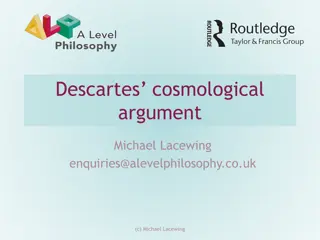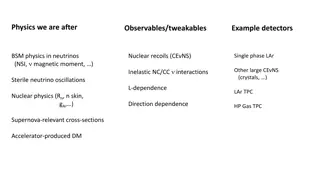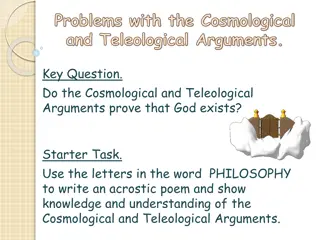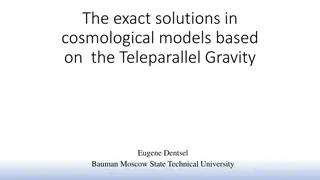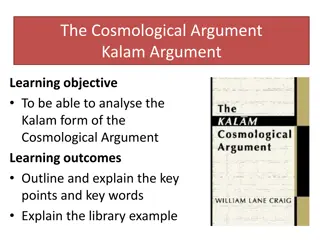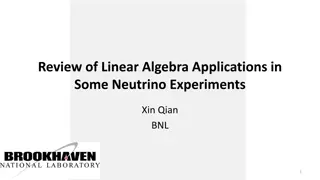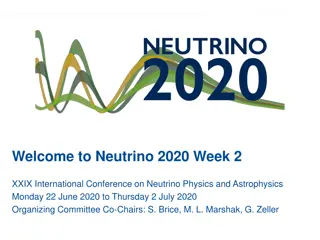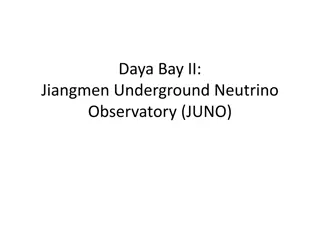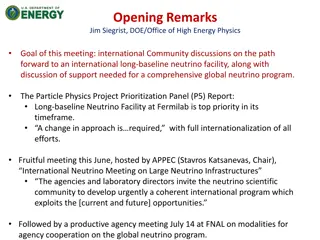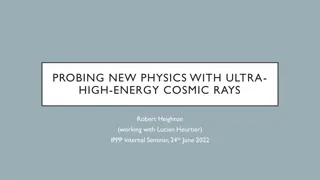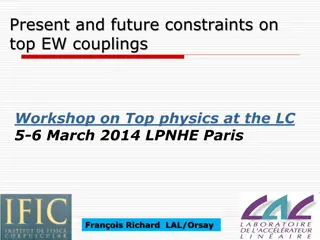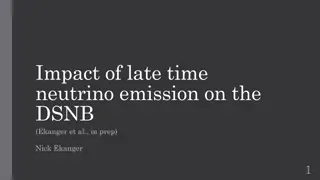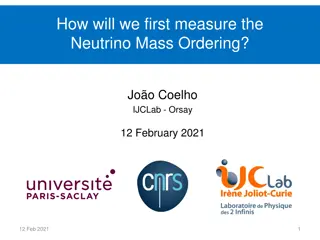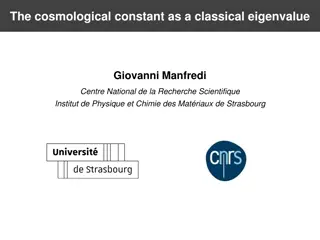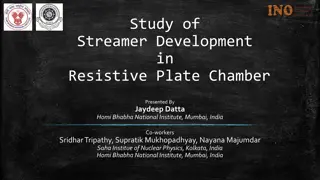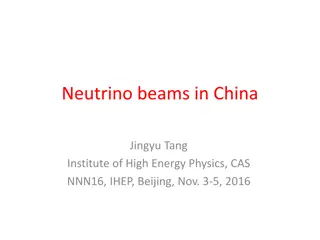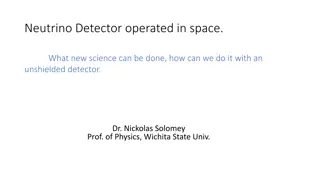Neutrino Mysteries Unveiled: Current Cosmological Constraints
Delve into the enigmatic world of neutrinos with a focus on their elusive properties like mass hierarchy, additional light neutrinos, and impact on cosmic background. Explore the unresolved questions surrounding neutrino physics from cosmological perspectives.
Uploaded on Sep 11, 2024 | 0 Views
Download Presentation

Please find below an Image/Link to download the presentation.
The content on the website is provided AS IS for your information and personal use only. It may not be sold, licensed, or shared on other websites without obtaining consent from the author.If you encounter any issues during the download, it is possible that the publisher has removed the file from their server.
You are allowed to download the files provided on this website for personal or commercial use, subject to the condition that they are used lawfully. All files are the property of their respective owners.
The content on the website is provided AS IS for your information and personal use only. It may not be sold, licensed, or shared on other websites without obtaining consent from the author.
E N D
Presentation Transcript
Current and future constraints on neutrino physics from cosmology Jan Hamann Rencontres de Moriond (Cosmology) 21stMarch 2016
What do we not know about neutrinos? We only know their mass-squared differences solar neutrinos atmospheric neutrinos but what is their absolute mass scale? -decay experiments oscillations
What do we not know about neutrinos? What is their mass hierarchy? normal m3 mass m2 m1 inverted m1 m2 mass m3
What do we not know about neutrinos? Are there additional(light) sterileneutrinos? Anomalies observed by Accelerator experiments Reactor experiments Gallium experiments Hints for additional state with m2 eV2? [Aguilar-Arevalo+ 2013] [Mention+ 2010] [An+ 2016] [Giunti&Laveder 2011] [Giunti+ 2014]
neutrinos decouple e+e-- annihilation
The Cosmic Neutrino Background (CB) Neutrino decoupling around T = 1 MeV, shortly before goes out of equilibrium Annihilation heats CMB relative to C B Neutrino mixing equilibrates momentum distributions If Treheating > 10 MeV, all three flavours populated
Impact of cosmological neutrinos Structure formation Neutrinos Big Bang Nucleosynthesis
Neutrino parameters How much energy density do neutrinos contribute at early times? Fermi-Dirac vs. Bose-Einstein lower neutrino temperature photon energy density radiation energy density Effective number of neutrino species CDM: Neff = 3.046 (small deviation from Fermi-Dirac)
Neutrino parameters How much energy density do neutrinos contribute at late times? at early times? Fermi-Dirac vs. Bose-Einstein lower neutrino temperature photon energy density neutrino energy density Sum of radiation energy density Effective number of neutrino species neutrino masses CDM: Neff = 3.046 (small deviation from Fermi-Dirac) CDM: m = 0.06 eV (assumes lightest mass state is massless)
Impact of cosmological neutrinos Structure formation Background evolution Evolution of perturbations Neutrinos Background evolution Nuclear reactions Big Bang Nucleosynthesis
Free streaming Velocity dispersion large wrt size of potential well gravitational potential initial time x Cold dark matter Neutrinos escape from potential well, density perturbations get washed out neutrino gravitational potential later time x
Structure formation with massive neutrinos m = 0 eV m = 7 eV [simulation and movie by T. Haugb lle]
Matter power spectrum with massive neutrinos wavenumber [Figure from Abazajian+ 2013]
Neutrino masses and the CMB angular power spectrum [Planck collaboration 2015] Changing neutrino mass affects zeq and dA(zrec) Can shift CMB peaks back in place by tweaking c and H0 (geometric degeneracy of the CMB) Remaining effects (early ISW, late ISW, lensing) rather subtle for sub-eV masses For better sensitivity, combine with external data (or CMB lensing)
Planck constraints on the sum of neutrino masses No sign of non-zero neutrino masses [Planck collaboration 2015]
Effective number of neutrinos and the CMB angular power spectrum [Planck collaboration 2015] Also subject to geometric degeneracy In addition, changes damping scale, anisotropic stress (partially degenerate with spectral index/amplitude of primordial spectrum) Planck measurement of damping tail greatly improved sensitivity
Planck constraints on the effective number of relativistic species Data confirm standard model expectation (C B only, no more hints of additional light particles) [Planck collaboration 2015]
Planck results vs. BBN Deuterium abundance from damped Ly- system 4He abundance from H II-regions Excellent match with BBN expectation + astrophysical element abundance measurements [Planck collaboration 2015]
Planck constraints on eV-mass sterile neutrinos Planck data not compatible with a fully thermalised eV-mass neutrino Want to save the scenario? Need to suppress production of steriles (e.g., lepton asymmetry, new interactions, etc.) [Planck collaboration 2015]
Matter power spectrum with massive neutrinos wavenumber [Figure from Abazajian+ 2013]
Matter power spectrum with massive neutrinos Non-linear regime Linear regime wavenumber [Figure from Abazajian+ 2013]
Nonlinear structure formation with massive neutrinos 0.15 eV 0.3 eV linear theory 0.45 eV 0.6 eV Theoretical prediction of matter power spectrum with massive neutrinos in the non-linear regime is a big challenge Simulations with CDM and neutrino particles Analytical methods [see previous talks] N-body simulations with neutrino particles, grid-based, hybrid approach [Brandbyge+ 2008,2009,2010; Viel+ 2010, Ali-Haimoud+ 2012]
Probes of the matter power spectrum CMB lensing 21 cm Lyman- forest Galaxy clustering Cluster counts Cosmic shear
Future sensitivity: CMB Stage-IV + CMB lensing (+BAO) [Abazajian+ 2013]
Future Large Scale Structure surveys BAO scale Cosmic shear Cluster counts Galaxy clustering Type Ia supernovae Geometric observables Perturbation-based observables
Future sensitivity: Planck + EUCLID shear PS/galaxy PS/clusters Sensitivity up to 10 meV for sum of neutrino masses, and up to 0.02 for effective number of neutrino species when observables are combined Can cleanly distinguish between effects of dark energy and neutrinos [Basse+ 2013]
Future sensitivity: Combining LSS observables Shear Galaxies (pessimistic) Galaxies (optimistic) CMB Beautiful complementarity between different observables: combination breaks parameter degeneracies of individual probes [Hamann+ 2012]
Direct sensitivity to mass hierarchy? Assume minimal mass in inverted hierarchy Probably not [Hamann+ 2012]
Conclusions The Universe continues to be boring: no evidence for anything unexpected in the cosmological neutrino sector With the next generation of large-volume galaxy surveys and CMB lensing measurements, a detection of the sum of neutrino masses is extremely likely, provided non-linear growth can be understood sufficiently well


